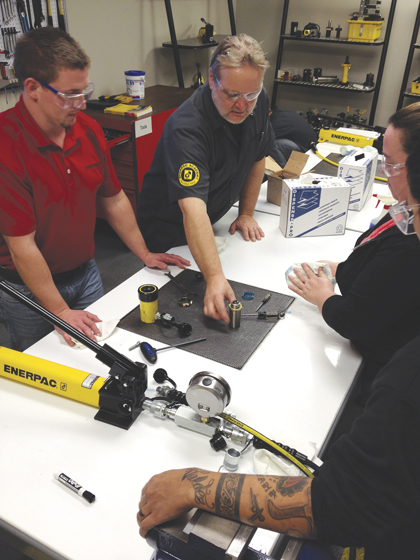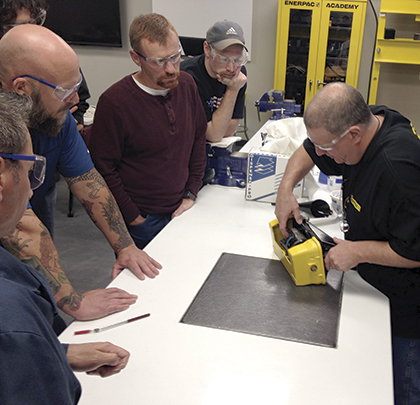The use of hydraulic technology allows for a degree of high force and control that cannot easily be achieved with other forms of equipment. It’s generally accepted that hydraulic power is one of the safest methods of applying force. However, the very simplicity of high-pressure hydraulic tools can often lead to their abuse. Like most equipment, there are rules and processes to be observed to ensure the safety of operators and the longevity and efficiency of the equipment.
GOAL ZERO
The operation of high-pressure hydraulics requires sound knowledge of how they work and how they should be maintained. The correct use and maintenance of these tools increases safety and reduces risk—both for the operator and for the environment in which the tools are used. This is why Enerpac is committed to achieve “Goal Zero”—no harm to employees, customers, and end users of its products.
Goal Zero is part of Enerpac’s global commitment to improve workplace safety, making this initiative of tremendous value to Enerpac customers. Serious injuries can happen on a jobsite, nevertheless many of these incidents may be avoided if workers’ pay attention to the hazards and potential risks and know how to use their tools correctly.
SAFETY AT EVERY LEVEL
For Enerpac, safety on the job is more than just using tools correctly; it’s an integral component of the company’s engineering, manufacturing, and product training efforts. Enerpac employees participate in the same classes offered to customers and distributor representatives, and plants provide monthly safety trainings for employees. Additionally, Enerpac hosts required activities for employees to participate in as an effort to identify potential safety risks. This allows situations to be corrected before injury occurs. The internal safety program each year becomes more comprehensive with the goal to increase safety awareness across the organization.
Enerpac offers a wide range of training services focusing primarily on safety, maintenance ,and the proper operation of high-pressure cylinders, pumps, bolting tools, presses, and accessories. Training services are available both in-house and on-site for users of Enerpac products. For many, these training services are required by an employer to ensure the proper and up-to-date usage of equipment. A certificate of training is issued containing a license number and certification date after the completion of each in-house course.
On-site services include safety training and tool crib audits. Safety training covers the proper use and maintenance of high-pressure hydraulic tools along with hands-on guidance. Tool crib audits generate detailed reports summarizing the condition of tools from a visual inspection along with suggested improvements.

Featured Image: Enerpac Academy instructor explaining how the Turbo II Air Hydraulic Pump functions.
Above: Enerpac Academy instructor guiding the class in the disassembly of an RC cylinder.
ENERPAC ACADEMY
In-house is the Enerpac Academy, which provides employees, distributors, dealer services personnel, and customers from around the world with a facility to learn about the functionality and service of all Enerpac products. Training centers are located in distribution and manufacturing centers in the United States, the Netherlands, India, Italy, Singapore, and Australia. Each training center features a designated classroom and product demonstration area. Each training course is led by well-qualified instructors and designed to be highly-interactive with a strong, hands-on element. Safety is always at the forefront of each training class, so participants learn how a product performs and functions before any hands-on training begins. The tools used during training are suitable for live demonstration and operation by participants.
In 2016, at the U.S. facility, Enerpac trained around 200 people—employees, distributors, dealer services, personnel, and end users. That number is anticipated to grow by 30 percent in 2017. Additionally, in 2017, the U.S. training room will be renovated by adding 200 square feet allowing for more product displays for class offerings. Finally, also planned for 2017, is the addition of new training courses, such as the bolting service repair workshop and an expansion of online training offerings.
Here are examples of the types of items covered in training, along with some quick tips:
- Operating instructions should be studied carefully before using any hydraulic equipment to know the product’s proper function and how it performs.
- Inspect equipment first before beginning work for potentially dangerous conditions, such as damaged hoses, couplings, and cylinder plungers.
- Checking work environments for potentially dangerous conditions, such as oil temperatures over 150 degrees Fahrenheit, dangerous electrical connections, poorly ventilated spaces, trip hazards, spilled oil, flammable liquids, or standing water.
- Always use the proper and required personal protective equipment when working with hydraulic tools, including safety glasses, heavy-duty work gloves, steel toe work shoes or boots, and hard hats when required.
- Obey the 80 percent rule—do not exceed 80 percent of the manufacturer’s maximum ratings for load and stroke.
- Never have loose components in the system setup, secure all parts before the lift beings.
- Never put any part of your body under a load without cribbing the load first. ■
For More Information
For more information about the safe operation of hydraulic equipment at Enerpac, visit www.enerpac.com.
_________________________________________________________________________
Modern Contractor Solutions, August 2017
Did you enjoy this article?
Subscribe to the FREE Digital Edition of Modern Contractor Solutions magazine.



